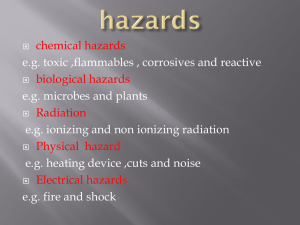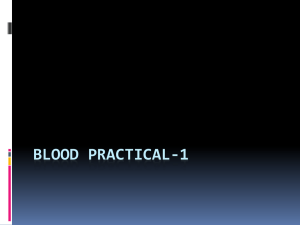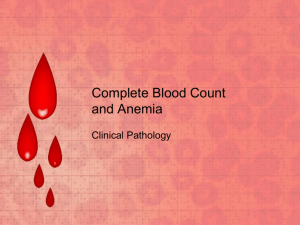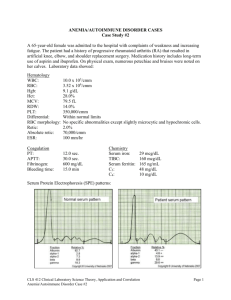CBC and ESR first year
advertisement
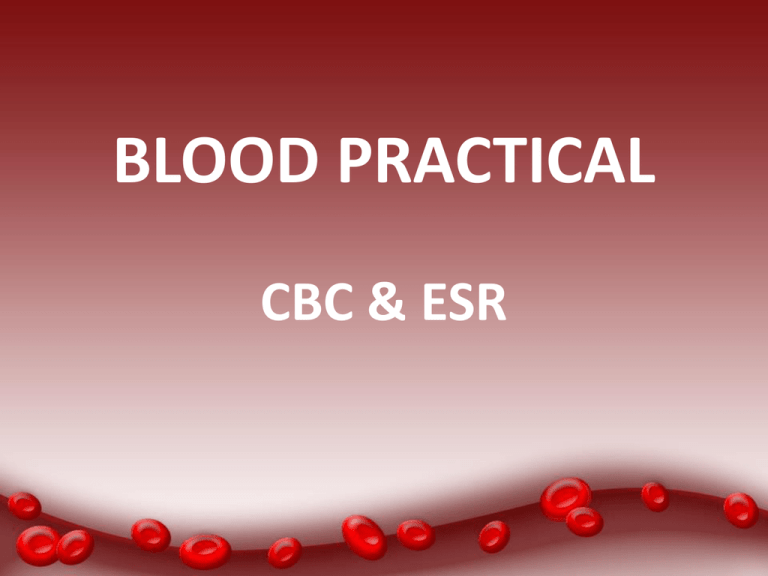
BLOOD PRACTICAL CBC & ESR Aims of the Practical 1. 2. 3. 4. Counting Red blood cells. Counting White blood cells. Determination of hemoglobin concentration. Determination of packed cell volume (PCV) hematocriet. 5. Calculation of red blood cell indices. 6. Determination of ESR. Objectives (CBC) At the end of this lesson the student should be able to: 1. Recognize the method used to measure the different hemato-logical values, and compare it with the normal values. 2. Do the calculation of indices, their normal values and their importance in diagnosis of different types of anemia. Objectives (ESR) At the end of this lesson the student should be able to: 1. To know how to measure the erythrocyte sedimentation rate. 2. To recognize what is the clinical value of taking these measurements. Complete Blood Count (CBC) • It is a test panel requested by a doctor or other medical professional that gives information about the cells in a patient's blood. Coulter Counter Coulter Counter Principle • It count and measure the size of the cells by detecting and measuring electrical resistance when a liquid pass through aperture. • While passing the aperture, the cells impedes the current and causes a measurable pulse. • Number of pulses --> number of particles. • Height of pulses --> volume of particles. Materials and methods • • • • • Coulter analyzer Diluent reagents Lytic reagent Calibrator kit EDTA anticoagulant blood RBC, WBC cell count & HB • • • 5ml of venous blood will be drawn in EDTA anticoagulant tube. Diluted by the reagent I and used to count RBC. Lysing RBC using reagent II and used for counting WBC and Hb. Normal values Male RBC WBC HB Platelet 4.5-6.5 x106/l 4 – 11 x103 /l 13-18 g/dl Female 3.8-5.8 x106/l 4 – 11 x103 /l 11.5-16.5 g/dl 150-400x103 150-400x103 /l /l Average 4.7–6.5 x106/l 4 – 11 x103 /l 13 –18 g/dl 150-400x103 /l Clinical application 1. 2. 3. 4. 5. 6. RBC = aneamia RBC = polycythemia WBC = leucopenia WBC = leucocytosis Platelets = thrombocytopenia Platelets = thrombocytosis Clinical application Low numbers of RBCs may indicate: • Blood loss: – Anemia (various types). – Hemorrhage. • Bone marrow failure (for example, from radiation, toxin, fibrosis, tumor). • Erythropoietin deficiency (secondary to renal disease). • Hemolysis (RBC destruction). Clinical application High numbers of RBCs may indicate: • Low oxygen tension in the blood – Congenital heart disease – Cor pulmonale – Pulmonary fibrosis • Polycythemia vera. • Dehydration (such as from severe diarrhea). • Renal (kidney) disease with high erythropoietin production. Clinical application High numbers of WBCs (leukocytosis) may indicate: • Infectious diseases. • Inflammatory disease (such as rheumatoid arthritis or allergy). • Leukemia. • Severe emotional or physical stress. • Tissue damage (burns). Clinical application Low numbers of WBCs (leukopenia) may indicate: • Bone marrow failure (for example, due to infection, tumor or fibrosis). • Presence of cytotoxic substance. • Autoimmune/collagen-vascular diseases (such as lupus erythematosus). • Disease of the liver or spleen. • Radiation exposure. WBCs Differential Cells Neutrophils shape Number of cells 59 % 40-60% Eosinophils 3 1-4% Basophils 1 0.5-1% Monocytes 5 2-8% Lymphocytes 32 20-40% Total 100 100% Clinical Application • Leucocytosis: High WBC count, in infection, allergy, systemic illness, inflammation, tissue injury. • Differential count provides clues about certain illnesses --> 1. Neutrophilia: pyogenic illness. 2. Eosinophilia: Allergy. 3. Lymphocytosis: infectious mononucleosis. Clinical application Platelet count: Thrombocytosis Chronic myeloid leukaemia. Thrombocytopenia A plastic anemia. Chemotherapy. The packed cell volume (PCV) hematocrit • The ratio of packed blood cells volume to plasma. Dr Sitelbanat 2011 The packed cell volume (PCV) hematocrit • • • • Capillary blood obtained from pricking finger tip after cleaning it with alcohol Fill a heparinised capillary tube, then seal one end by plasticine. Centrifuge for 15 minutes to packed the cells at one end of the tube leaving a clear plasma on top. Use the hematocrit reader to find the packed cell volume. Dr Sitelbanat 2011 Haematocrit Reader Dr Sitelbanat 2011 Normal value PCV Male PCV % 40-54 Female Average 35-47 35-54 Dr Sitelbanat 2011 Clinical application High hematocrit may indicate: • Dehydration – Burns – Diarrhea • Polycythemia vera. • Low oxygen tension (smoking, congenital heart disease, living at high altitudes). Clinical application Low hematocrit may indicate: • Anemia (various types). • Blood loss (hemorrhage). • Bone marrow failure (for example, due to radiation, toxin, fibrosis, tumor). • Hemolysis (RBC destruction) related to transfusion reaction. • Leukemia. The calculation of Red Blood Indices 1. Mean cell volume (MCV) – The average volume of red blood cell – MCV = PCV x 10 = 85 + 8 m3 RBC count 2. Mean cell hemoglobin (MCH) – The average weight of Hb in red cells – MCH = Hb x 10 = 29.5 + 2.5 pg RBC count. Dr Sitelbanat 2011 The calculation of Red Blood Indices 3. Mean cell Hb concentration (MCHC) – Concentration of Hb per 100 ml of RBC – MCHC = Hb x 100 = 33 + 3 g/dl PCV Dr Sitelbanat 2011 Normal values Average MCV 78-98 m3 MCH 27-32 pg MCHC 30-35 g/dl Dr Sitelbanat 2011 Types of Anemia RBC HB PCV MCV MCH MCHC Type of anemia cause Case A Low Low Low Low Low Low Microcytic Hypochromic Iron deficiency Case B Low Low Low high N/ high N/low Macrocytic megaloblastic Vit B12 or Folic deficiency Erythrocyte Sedimentation Rate (ESR) • Is the rate at which red blood cells sediment in a period of 1 hour. • non-specific measure of inflammation. Dr Sitelbanat 2011 RBC Sedimentation • Is controlled by the balance between plasma protein fibrinogen, and the negative charge of the erythrocytes. • In inflammatory, the high fibrinogen level causes RBCs to stick to each other to form stacks (rouleaux), which settle faster. Dr Sitelbanat 2011 Rouleaux formation Dr Sitelbanat 2011 Material and methods • Westergren’s sedimentation apparatus. • Anticoagulant (EDTA). • Disposable sterile syringes and needles. Dr Sitelbanat 2011 Westergren apparatus Procedure 1. Using a sterile syringe remove 1.6ml of blood from a suitable vein. Transfer it to a test tube containing EDTA and then draw up blood into a Westergren tube exactly to the zero mark. 2. Place the tube upright in the stand and leave undisturbed. The height of the column of clear plasma at the top of the tube is noted at the end of an hour and again at the end of 2nd hours. Dr Sitelbanat 2011 ESR Results • Normal ESR in male = 3-5 mm/ 1st hour and 7-15mm/2nd hour. In females values are slightly higher. • Moderately elevated ESR occurs: inflammation, anemia, pregnancy, and old age. • A very high ESR associated with multiple myeloma, polymyalagia Rheumatic, temporal arteritis. Dr Sitelbanat 2011 Clinical application of ESR • • • • Nonspecific test. Prognostic not diagnostic. Monitor disease activity and response to therapy. ESR is a nonspecific marker of inflammation and is affected by other factors, ESR results must be used along with other clinical findings. Dr Sitelbanat 2011 C-reactive protein & ESR • C-reactive protein is an acute phase protein produced by the liver during an inflammatory reaction. • Since C-reactive protein levels in the blood rise more quickly after the inflammatory or infective process begins, ESR is often replaced with Creactive protein measurement. Dr Sitelbanat 2011 Thank you


